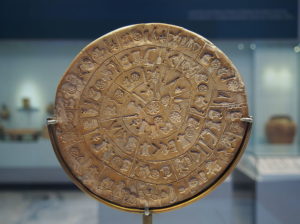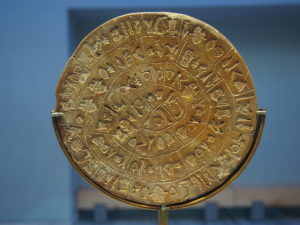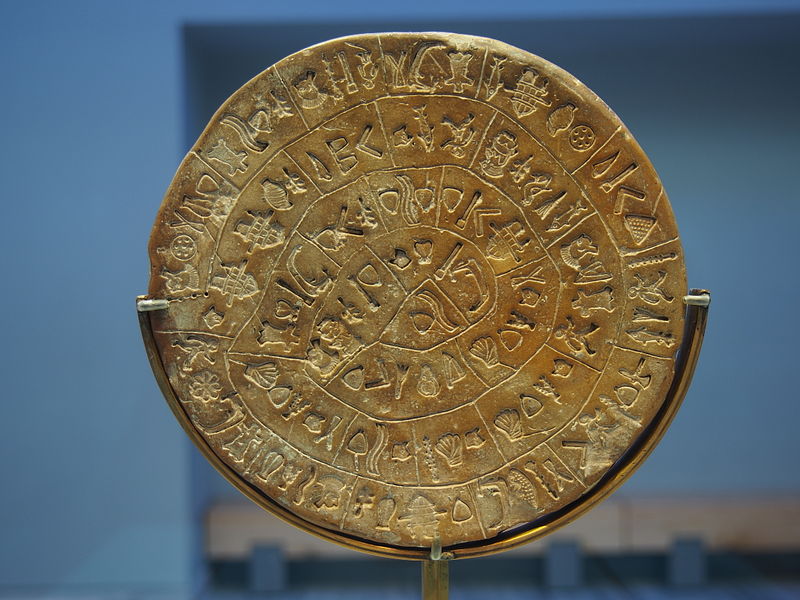
In 1908, a most mysterious object was discovered in the palace complex of Phaistos on the island of Crete. The object was a small disk of fired clay, about 6 inch in diameter, and held symbols of unknown meaning in a spiral formation. Both sides of the mysterious Disk displayed stamped images grouped within defined lines.
The Phaistos Disk was discovered by Italian archaeologist, Luigi Pernier, and was unearthed from a temple depository on the basement level in a building northeast of the main Palace. It was found with a few other items; ashes, burnt bones of cattle, and a nearby tablet consisting of the unsolved Linear A script. These items suggest a placement and burial of the Disk as having been part of a sacred ritual to possibly ward off evil or protection of harm from coming to the developed area. From this idea, the symbolic writing on the Phaistos Disk is believed to hold a magical charm of sorts to some researchers. The interring of objects for such belief was a practice known in the time, and so the theory is definitely sound.
However, without understanding what the Disk does definitely ‘read’ or knowing the exact origin of the Disk, everything about it, even its purpose, remains still in question. One of the huge anomalies to the dated 1700 BC object, is the ‘stamping’ of symbols into soft clay, later heated, on the Disk. This is a method of writing (movable type) which wasn’t realized until a much later time. The Phaistos Disk’s advanced design stands alone at this stage of civilization.
For this reason, many scholars wonder about its authenticity. They question; if stamps were used to ‘print’, suggesting the stamps could be used more than once, then why hasn’t multiple other examples of the Disk’s symbols been found on other artifacts? Plus, why haven’t any of the ‘stamps’ themselves been found, or the advanced method of printing used to create the Disk further utilized by others in the time?

These questions continue to be asked, and although some scholars believe the Phaistos Disk could be a hoax because of those bafflements, along with circumstances surrounding the find which did allow opportunities for placing a forged object, historical evidence actually suggests otherwise.
One of the most convincing factors to conclude the Phaistos Disk is indeed real is the discovery of a few other mysterious objects which are without question of authenticity. These objects are the Arkalochori Axe, the Ring of Mavro Spilaio, and a Sealing.
The Arkalochori Axe has an inscription on it of 15 symbols and was found in 1934 in a cave on Crete. It shares a few similar symbols to that on the Phaistos Disk. The Mavro Spilaio gold ring displays symbols written in spiral form like that of the Disk. And the Sealing, found in Phaistos 45 years later, includes a symbol matching one on the Disk. The only one known. These ancient artifacts are deemed genuine and remain almost just as mysterious, but their findings support the Disk’s validity.
So then the mystery moves to ‘What might the Disk say or represent?’ There were 241 impressions made into the clay faces of the Disk and are made from 45 individual symbols. These symbols seem to create ‘words’ by differing amounts of symbols being separated by lines etched on the Disk. The longest string or group of symbols being 7 in a row.
One side consists of 30 groupings of symbols and the other side contains 31.
Although the images are of common items and identifiable, how they might be used in order to ‘read’ is another matter, and a mystery. Because there are so few symbols, and examples of them discovered, the meaning upon the Phaistos Disk might never be deciphered until more artifacts containing like symbols are found.
For over a century, since its discovery, the Phaistos Disk has mystified researchers. While many theories and decipherments are put forth, none are conclusive or agreed upon.
It seems the Phaistos Disk is one object which will keep its secrets. At least for now.
Best of luck with all that you seek! Treasure the Adventure!
Subscribe today to the MW newsletter for exciting fun and treasures each month.


A prayer formed in a spiral?
Prayer to a Minoan Goddess?
•IQEKURJA, which may mean “pregnant mother” and/or “goddess.”
•IQE, which may mean “mother” and/or “goddess” and which appears repeatedly on the disk.
•IQEPAJE or IQE-PHAE, which may mean “shining mother” or “goddess.”
https://youtu.be/aeOo2OnaPBE
The burnt bones of cattle does seem like it’s related to ancient worship.
I’m no an expert, but it seems to me that cattle offerings were made to sea gods in a wide range of areas and peoples. Maybe also a storm god, I don’t recall now.
That tablet seems like a story. It’s fun to try to figure it out, what with walking man and such images. But that doesn’t mean anything, like hieroglyphs the symbols used together form something else more like a phrase, so the direct meaning is ambiguous. Or maybe I’m wrong about that too. I’ve always wanted to study that sort of stuff more.
Thank you for your thoughts Buckeye Bob….
It could be anything….and like you, I would love to study more about and in depth on it…. So much I would love to study…lol and only so much time….so we do what we can….and love it all still…
Love that idea, 23kachinas! And yes, that link you gave is one possible decipherment, but not conclusive or agreed on.
I personally love your idea of a prayer being written on the Disk, and do feel the Disk was placed during a special ritual to have the ‘prayer’ be with the people in Phaistos. But what does it say exactly is the question.
In the link attached below I write about one of the oldest board games known and it is in form of a spiral. Games of ancient times had sacred significance and were often only played by adults for a way to ‘enact’ what the game represented. It is believed you traveled inward to the serpents head at center and then back out on the game.
I feel then the Disk is read inward on one side, and then back out on the other side…..
https://mysteriouswritings.com/mysteries-of-mehen/
just thoughts….
The idea that the disc is read inward and then outward hits on something in my memory that I can’t quite recall. Some other ancient thing that’s not a disc.
Maybe one of those cylinders that were placed upright and spun in prayer or ceremonies. I don’t recall.
But somewhere else, I am sure I’ve seen that system (back and forth, so to speak) where it seemed contrary to a normal way of doing things. As if we read our sentences left to right, then right to left, then repeat. That kind of contrary. But yet, not necessarily.
err, not necessarily contrary to THEM.
Cool story, Jenny. Thanks!
The symbols on the disk being found elsewhere…to verify it’s authenticity…is fascinating.
It reminds me of another mysterious story about the ancient copper mines in the Michigan/Great Lakes area.
http://www.science-frontiers.com/sf090/sf090a01.htm
I heard that the shape of the smelted and poured copper ingots there…the “animal hide shape”…has been found in hieroglyphs in Egypt referring to metal…particularly during the reign of Queen Hatshepsut. Of course, the copper could have been flowing into Egypt for a long time before that.
The bronze age in Egypt began in about 3150 BC…and the main component of bronze is copper.
What’s even more interesting is the fact that the copper coming from the ancient mines in Michigan is very pure and has a unique chemical signature. I heard that the same copper signature has been found in Egypt.
The world is chock full of mysterious and lost history.
I hope I get to watch it all like a movie some day.
Don’t you wonder about that?
I’ve seen other accounts of possible interactions between America and Europe, Asia, Africa, and the ME too.
There could be a lot of lost history involved.
Thanks JC1117 for sharing that story….another totally awesome mystery I need to check out…..
You are so true, there is so much to explore in this world!
Cool beans Jenny. This link has a little more info on the current linguistic interpretations.
http://www.huffingtonpost.com/2014/10/28/ancient-cd-rom-phaistos-disk-code_n_6055178.html
I always think it’s funny to try and come to some “definitive” answer as to what something like the Phaistos disc is. Lotta different factors that we can’t fully appreciate about ancient objects, since we are so far removed from them by time, language, and culture. If we were all gone today and aliens showed up 4000 years from now and found a Spider-Man comic they would think we worship spiders and our shaman was named Peter Parker. Or if they found a Rubix Cube that would obviously mean we worship squares and grid patterns. What might they say about Christmas trees. “So the humans cut down a tree that is outside, then bring it inside, stand it back up, then throw tinsel and decorations on it, and put tiny electric lights on it? Wow, so humans worshiped trees . . . or was it a mating ritual?”
Thanks for the post Jenny. Lovin’ em.
lol…. great points Bailey. History will keep getting more difficult to decipher…. lol…
Looks backwards to me, side A should be side B, because it appears to be a snake. Side B looks like the head in the center and side A is the tail in center. Both sides have writting outside/around the body of the snake, like a C, the snake body side A to B is joined at the C opening. IMO, just my first
impression of the artifact.
Hi NearIndianaJones, Interesting perspective….Thank you. I’m not sure if you clicked on the link about MEHEN…but this is one of the oldest board games(2500BC) which is in spiral form like the Disk and is a ‘snake’. The game held sacred significance. I feel there is a connection to the spiral format and snake to the Disk.
Thanks for posting Jenni, where do you find the time to post so much intriguing stuff. We’re all glad you do.
It looks like a leap year calandar to me.
12 outside boxes and 18 inner boxes.
Balancing to nine days to add every 36 years.
It appears to be describing a minimum of 36 years or could be 72 years each side for a total of 144 years. It is something resulting in a 4 factorization of 36 since 1/4 days are added each year for 1 day every 4 years or 9 days added every 36 years. To balance the calandar ancients added days as needed like on side A. But the calandar on side B appears to be more ordered. 13 months would give 28 day months correlating exactly to the moons phases.
Since side A seems more random they may be in the data collection phase of creating a balanced calandar so alot of days were added to year one, then days added as needed to make it balanced, after 72 years they created a more ordered calandar of observation and wrote it on side B a 36 year calandar. It seems to relate to results with a factor of 4 (.25×4=1 day to add).
This calandar would be divided into 13 month with 28 day months. The outer wheel is first 12 months and the inner boxes starting at the opening on the outer wheel are the 13th month of each year for 18 years. A day would also be added each year to get 364 (13 months) to 365 (actual solar calandar). The months could be divided into nine day weeks with one day added to the months like the a day added on an average of every forth year.
Boxes have symbols for every week name. Symbols denote divisions of nine days (3 symbols) seven days (4 symbols). Or some symbols in three symbol boxes could be denoting two week 14 day period.
More symbols than four show leap year days to be added occurring in average every 4 boxes or on average every fourth year one day to be added. There are actually 18 occurances of this on side A which would be 18 added days for 72 years, side B also correlates as there are 9 added symbols for 36 years on its side the minimum and refined version is side B? So the weeks names and the added day names were clearly significant and probably had meanings that related to their cukture like weather, water, planting, harvesting, building, and ceremonial times.
I wonder if this a yearly calander record of 36, or 72 years of the history of a people or specific person like the life record of a king.
Or is this a 36, 72, 108, 144 year calandar to lay out the future like a type of early farmers almanac.
Or perhaps it is just jibberish just a child’s school work from ancient times.
Wow….impressive…:) Could be as you say. Enjoyed reading your ideas. I suppose that is what I love about ‘mysterious things’, they encourage and inspire us to think and realize how amazing the world was….and is.
There’s certainly some strangeness to these symbols.
Many look like natural symbols of grain, fruit, and animals/fish.
Then there’s some that look like ancient weapons, a club/mace in particular. But that one could be a tool.
There’s one symbol that looks like some sort of fruit, or a nut, and looking on side B I see one of these with what looks like it has a stem attached. Possibly meaning harvested and unharvested fruit?
The strangest is the one that looks like a large building with many doors or windows. But they didn’t have structures that advanced, I don’t think. Plus is has some strange attachments on the bottom. This is the most out of place symbol, in my mind.
Wow! How did that get in Crete? It is from Munchkin Land. It’s the very beginning of the Yellow Brick Road. Incredible!
These other Minoan artifacts are not convincing evidence of a Minoan origin for the disk. 1.) The signs on the ax look nothing like the signs on the disk. 2.) The spiral is a universal sign and is therefore evidence of nothing whatsoever. 3.) The sealing has only a surface resemblance to the sign on the Phaistos Disk. The sign on the disk has “serif” corners, while the sealing has rounded corners; the disk’s sign has 4 “teeth” on either side, whereas the sealing (look closely!) has 4 on one side and 5 (4 plus the stub of a fifth) on the other. These differences are enough to make any resemblance between the two, mere coincidence.